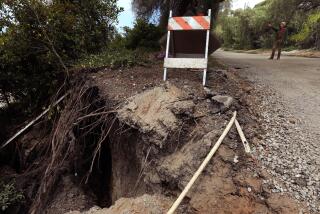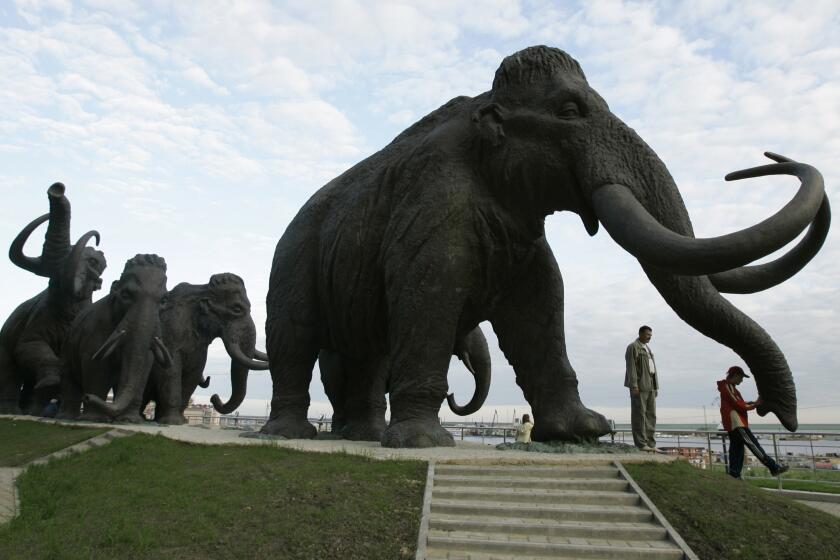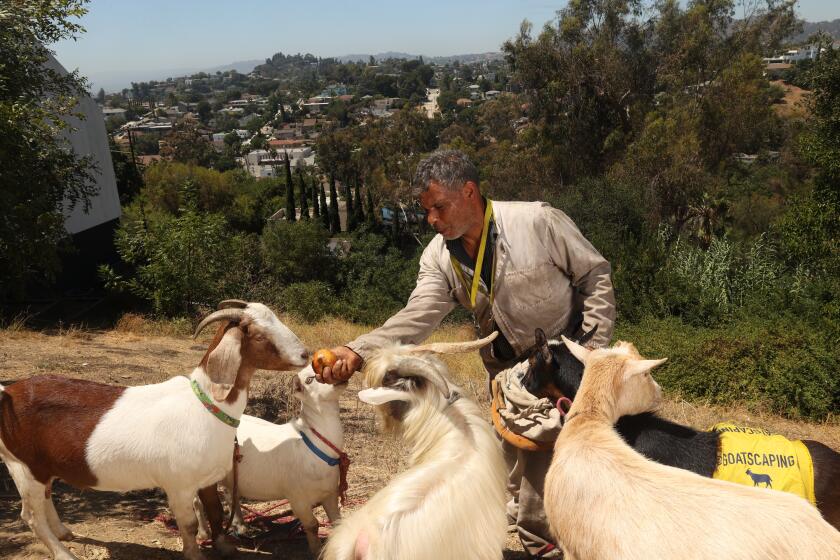Cattle and Coyotes : 95-Year-Old Mountain Man Spins Yarns of a Rugged Past
At 95, Granville (Granny) Martin makes a few concessions to age, the chief among them being that he talks only about his past, those early days when he ran cattle in the desert flatlands, trapped skunk and other varmints in the woods, courted Molly Birdsell at Saturday night dances before settling down with his bride of 69 years “on a little old spread” near Descanso.
“I’m so glad I lived when I did that I don’t care now when Gabriel blows his whistle,” Granny tells anyone interested in listening.
In his mind and on his tongue are thousands of images of San Diego County’s backcountry--”old Everett Campbell going up the road in his spring wagon with a jack rabbit hanging down off the back end,” and “old Doc Myers” making his rounds on a blooded stallion “that was too much of a horse for him to handle and he knowed it.”
There was that 22-year-old Irish lass fresh out of Normal School, his first-grade teacher with whom he walked a mile and a half to school each morning.
“She was scared to death of them cattle,” which grazed along the path they took and would run over to get a better look at the two-legged creatures.
“People didn’t walk much in those days,” Granny explained, “and them cattle would come up to us to get a better look. She’d scream, and we’d run and roll under the fence, and then a bunch of them cattle on that side would come at us, and we’d have to run and roll under the fence again.”
Those days are gone, Granny believes, because of the “gol-darned government men,” whom he refers to as “parasites” and blames for having ruined the land of his youth, “the beautiful fields and livestock pasturage and stuff” that they “cluttered up with concrete and numskulls and such.”
The worst of all of them was “old Franklin (Deceitful) Roosevelt with his CC camps and his WPA, coming into the mountains and changing the proper order of things.”
When the government took over the mountains and the valleys and the desert--much of San Diego County’s backcountry--and turned it into state parks and national forests, in Granny’s opinion it was the end of the good life.
Granny Martin was born in San Diego in December, 1895. His mother took him back to the mountains a few weeks later to the logging camp on Sawmill Mountain where his father was working at the time.
“My mother and me came up on the old stage to Descanso, but the driver, he didn’t want to take the big team up the grade. He only had me and my mother and a bunch of mail to carry, so he took us up to Cuyamaca in a single-seat spring wagon.”
He tells about his father trudging on snowshoes “down to town” in Julian to fetch malted milk powder for him that cold winter of ‘96, and acknowledges that he was a sickly child, although a picture of him--a chubby 6-month-old with a horse collar for a playpen--belies that statement.
His wife, Molly, 89, came to Cuyamaca and Sawmill Mountain from Bakersfield with her folks in 1902 when she was 2 months old. Her father took over the sawmill job that Granny’s father had worked, driving a team of oxen up the mountain and hauling logs to the mill.
“In those days, you know, we had to get our own meat, and he’d take the rifle and go looking for something to eat, and we’d take the team back. It was a wonderful life, you know,” she said.
Granny can top that one, and he does, telling about his trapping experiences.
There wasn’t much for kids to do in those days, Granny said of his turn-of-the-century childhood, “and the only way we could make a little money was by trapping. Everybody trapped. Wildcat and coyote, ‘coons and skunks. The most of it was skunks, and they wasn’t worth much and the worst to handle.”
Granny rode a burro--a wild burro--”but I taught him a lot of things,” and carried a gun while running his traps on his way to school. He said he needed the gun because Indians on a nearby reservation had a lot of dogs, and some of them got caught in Granny’s traps.
“By golly, those dogs, they would just be biting and frothing at the mouth, and I was scared of them. In those days we were scared of hydrophobia (rabies),” he explained, “so I’d shoot ‘em. Others that wasn’t so bad, I’d just whomp ‘em aside of the head with the butt of my gun,” then release them and let them recover and escape.
“They didn’t get caught in that trap again,” he said.
Once, the schoolteacher asked Granny to bring a coyote to school to show the other children, not specifying whether it should be alive or dead.
“So I catch a coyote and batted him upside the head and put him to sleep and loaded him on the burro and took him to school. I called to the teacher, ‘Here’s your coyote,’ and I dumped him on the porch. She come running out and called to the children to come and see,” he recalled.
“Then that old coyote started stumbling around, and she started yelling and running, and she run back into the schoolhouse with him following her, following the noise and all. When I got in there, she was up on top the organ and the old coyote was still sort of crazy and stumbling around. So I caught up with him and knocked him upside the head, and then the kids all saw that I had that gun and they thought that was something.”
Granny’s father, Bill Martin, was a carpenter by trade but took the jobs that were available during those rough-and-tumble days of the early 20th Century. He worked in logging camps. He was a mining claims assessor, a cowboy and for a few years--1911-13--assistant forest ranger for Cleveland National Forest, responsible for fire suppression from the Mexican border to Oak Grove near the present Riverside County line.
For his sons, Granny’s father wanted better. And he especially was against his children going into “cowboying.”
“My old dad told us, he said, ‘I’ve rode broncos all my life and cowboyed, and it don’t get you anywhere, and if you darn kids ever get on an old horse, I’m going to break your darn backs.’ And so, my brother and my sister and I, that’s all we ever did,” Granny said, chuckling. “My brother got out. He did a number of things. The Depression is the only thing that made me change. Cowboys was two bits a thousand during the Depression, and, after that, there was no place for a cowboy.”
Granny got into the cattle business in 1909, and he’s in it still.
Granny and Molly weren’t childhood sweethearts, although their families must have crossed paths a number of times in their moves around the East County mountains. The couple met when they were both working at the same ranch at Boulder Creek. There were dances, Granny recalls, but Molly remembers that Granny “didn’t like dancing all that much,” but they liked each other a lot.
“It was five years before we got married,” Granny said.
The Army drafted Granny during World War I and promised him a “top job” at Camp Kearny. The job turned out to be as a hospital orderly, and Granny spent his military service “pushing bedpans” at the hospital. He never left San Diego County.
When he got out of the Army, jobless and penniless, Granny started to make the rounds of the ranches and landed a job cowboying for the Campo Cattle Co., nursemaiding hundreds of cattle during winter grazing in the desert and herding them up into the Lagunas to their summer pastures.
Granny and Molly were married on March 25, 1922, and he moved his bride to a “soddy”--a modest home built of sod blocks and the first of many houses that Molly would turn into a home.
During the Depression of the 1930s, Granny and Molly “headed north,” where Granny hoped to hire on as a hand at one of the ranches along the way. He found a job in Ashland, Ore., but found the snow too difficult to handle, so they came back.
The Martins, at Molly’s urging, decided to settle down for good.
“I said that the only place I knew of was just a little place--this place--that wasn’t worth much, couldn’t make a living on it,” Granny said.
But they bought it and made a living on it, raising cattle and their children.
“We’ve been here pretty near 55 years,” Granny said.
His 100-acre spread south of Descanso still supports the couple, and Granny still keeps 17 or 18 head of cattle around, but admits, “I’m lazy as the dickens now, and I don’t like to do anything except sitting down.”
Granny, at the peak of his cattle ranching, grazed about 200 head of cattle on about 20,000 acres of government land, “even though the government only allowed me 60 head.”
Many of the Martin children, grandchildren and great-grandchildren live “just up the road” or “over the hill” from the home place and keep an eye on the old folks.
And the Martins still vote. Granny has never missed an election since he was of age.
Guns have played an important role in Granny’s life--and still do. A firm believer in the right to bear arms, Granny has guns in his collection that date back to before the Civil War, as well as a single shot 50-caliber “buffalo gun” he made himself when he was 75. He once “shot the heads off a bunch of squirrels” with the unwieldy muzzle-loader, he said, but it has gotten too heavy for him to handle these days.
And the Martins still host the gun-toting, freedom-loving Mountain Men once a month at their home place, where the “old boys” get together to eat and “do a little shootin”’ and talk about the good old days when they were young and the country was free for the taking.
Granny said he’s not one for traveling and has never been far from the mountains of his youth. But he does have a hankering to go “up to that place where they have them faces of presidents up on the mountain.”
The couple’s daughter, Leah Walters, confides that her daughter is planning to take Granny to the Black Hills this summer to see the Mt. Rushmore carvings of Washington, Jefferson, Lincoln and Teddy (not Franklin Deceitful) Roosevelt.
More to Read
Sign up for Essential California
The most important California stories and recommendations in your inbox every morning.
You may occasionally receive promotional content from the Los Angeles Times.





